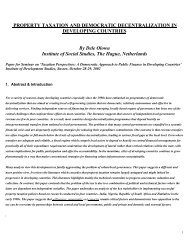View Article - Institute of Development Studies
View Article - Institute of Development Studies
View Article - Institute of Development Studies
Create successful ePaper yourself
Turn your PDF publications into a flip-book with our unique Google optimized e-Paper software.
18Simply put, interactions, negotiations and manoeuvring both at the local level as alsobetween the top and the bottom assume a dialogical character. 5 Therefore, our aim here isto examine forces underlying reforms and reciprocally, those unleashed by political andlegislative reforms. All these constitute parts <strong>of</strong> our enquiry <strong>of</strong> whether decentralisationmakes government more responsive to the needs <strong>of</strong> the poor.Differently decentralised: Our focus on varieties <strong>of</strong> decentralisation is inspired bythe fact that the States in India are larger than most countries in the world in terms <strong>of</strong>geographical territory and population. Understandably different regions <strong>of</strong> the country are‘differently democratic’ and ‘differently decentralised’. Consequently, we need to adopt adisaggregated approach that captures the diversity and complexity <strong>of</strong> Indian social, politicaland economic reality. Several scholars focus on ways in which the historical-social contexthas shaped the democratic institutions in different parts <strong>of</strong> India and reciprocally howsocial realities have been affected by such widely divergent patterns <strong>of</strong> democratisation. 6As we shall try demonstrate below, inter-State variations in decentralised reforms revealthemselves in at least three distinct ways : a) legislative reforms have followed very differentcourses in the selected States; b) political motives behind such initiatives have been quitedistinct, as has been the nature <strong>of</strong> social/historical forces that have either helped or hinderedthe reform process; and c) practical results <strong>of</strong> State initiatives have varied a great dealdepending on social and economic conditions, the nature <strong>of</strong> political parties, socialinequalities, the educational and political awareness <strong>of</strong> the public and so on. All this hassurely influenced the local features <strong>of</strong> respective Panchayati Raj Institutions (PRIs).The political/legislative narrative <strong>of</strong> decentralisation in West Bengal : Selection <strong>of</strong>West Bengal as one <strong>of</strong> the case studies is prompted by the obvious reason <strong>of</strong> its being inthe national forefront <strong>of</strong> decentralisation efforts for nearly three decades. Such a long andsecure tenure <strong>of</strong> the decentralised regime, that too under the tutelage <strong>of</strong> the same rulingcoalition throughout the entire reform period, provides us with a rare opportunity forstudying the ‘evolution <strong>of</strong> devolution’ in a meaningful way. Indeed, to mention it somewhatsimplistically and prematurely, as the process <strong>of</strong> decentralisation has unfolded over theyears in the State, PRIs have grown out <strong>of</strong> their role as ‘development’ panchayats (as mereappendage to the development bureaucracy) to assume the character <strong>of</strong> ‘political panchayats(spearheading, in concert with the CPI(M) party, the programme <strong>of</strong> agrarian reformslaunched by the State government). But with decelerating agricultural productivity growth





